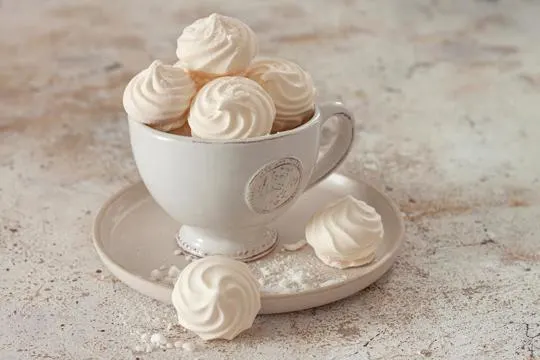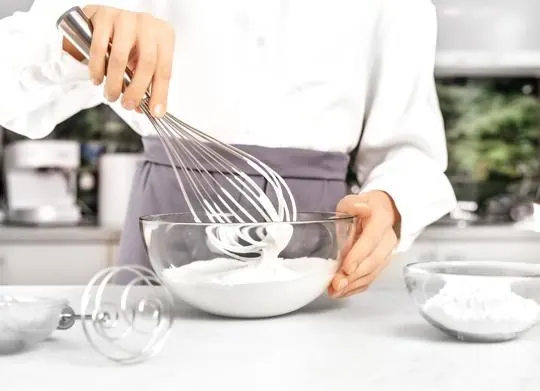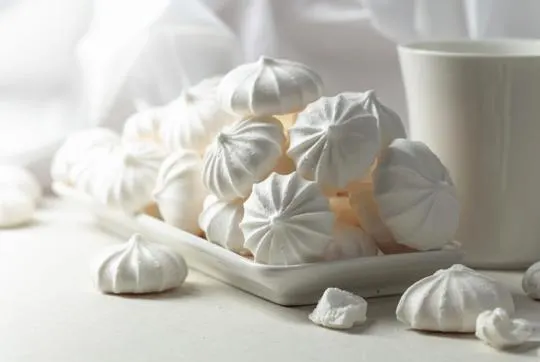Summary of key points
The main difference between meringue and whipped cream is the ingredients used. Meringue is made from egg whites and sugar, while whipped cream is made from heavy cream and sugar.
This distinction results in different textures and uses for these two toppings. Meringue has a light and airy texture with a crisp exterior when baked, making it popular for topping pies or as a base for desserts like pavlova. Whipped cream, on the other hand, has a creamy and smooth texture that pairs well with fruits or as a topping for hot cocoa or coffee.
In terms of health, meringue is lower in calories and fat compared to whipped cream, making it a slightly healthier option. However, both can be enjoyed in moderation as part of a well-balanced diet.
Meringue and whipped cream often find themselves in a standoff on the dessert battlefield. We’re here to break it down.
Meringue, that airy, crispy cloud, owes its existence to beaten egg whites and sugar. Whipped cream, on the other hand, is like that creamy, smooth dream, thanks to heavy cream hit with a whisk.
I once swapped these in a pie recipe. Catastrophe? Pretty much. Lesson learned. We need both in our lives, for very different reasons. They’re not interchangeable. Personal preference plays a huge role in picking sides.
Our kitchens have seen many a dessert disaster. This is another tale. All in the name of sweet victory.
What is Meringue?

Meringue is a light and airy sweet, made from egg whites and sugar.
Make it by beating the whites until they are stiff, while gradually adding sugar.
It can be baked or toasted for diverse textures and flavors.
It’s used to top pies, cakes, and tarts, adding a delightful sweetness.
It stands out from other confections due to its stability during baking.
This is because the egg whites form a sturdy structure.
Meringue can even be shaped into various forms like nests and shells for attractive presentations.
It also has special properties when cooked.
Three types are French, Italian, and Swiss.
French meringue is created by whisking sugar into beaten egg whites until stiff peaks form.
Then bake at a low temperature for a long time.
Italian meringue needs hot sugar syrup added to the whites and beat until cool and glossy.
Swiss meringue is heated over simmering water and whisked until fluffy.
Meringue is different from whipped cream, as it adds lightness and stability to desserts.
Whether it’s piped peaks or a nest for fruits, meringue adds a unique touch that impresses the eyes and taste buds.
What is Whipped Cream?

Whipped cream – a luxurious treat.
Beat heavy cream until it thickens for a dreamy texture.
Tiny air bubbles make it fluffy and light.
Sweeten with sugar or vanilla extract for extra temptation.
Add powdered sugar or gelatin to stabilize and decorate cakes or pastries.
Not just desserts – try it in drinks too.
Whipped cream adds indulgent touches to coffee, hot chocolate, and dairy-based cocktails.
Enjoy its creamy flavor and make every dish special.
Differences Between Meringue and Whipped Cream

Meringue and whipped cream both have light, airy textures.
But, they differ in taste and ingredients.
Ingredients Used
Creating a delicious dessert? The ingredients used matter.
Let’s take a look at meringue and whipped cream – two popular options for adding sweetness and texture.
Both have unique characteristics that will elevate your culinary creations.
Meringue is a sweet treat made with egg whites and sugar.
It has a light and airy texture, like a fluffy cloud.
It can be piped into shapes and forms before being baked or torched, for a crispy outer layer.
It’s great as a topping or ingredient for pies, tarts, cakes, and more.
Making meringue requires precision and patience – overbeating or underbaking can ruin the result.
Whipped cream is made by beating heavy cream until thick and creamy.
Sugar adds sweetness and helps stabilize the cream.
It’s smooth and velvety, perfect with fruits, hot drinks, or as a filling for cakes and pastries.
It doesn’t need baking – just beat until peaks form and it’s ready to go.
Meringue and whipped cream both add indulgence to desserts, but they offer different flavors and textures.
Meringue provides a delicate crunch that melts in your mouth.
Whipped cream offers a rich and creamy sensation.
Texture and Consistency
Meringue and whipped cream may look similar, however, they are quite different when it comes to texture and consistency.
Meringue is light, airy and has a crisp outer layer, whereas whipped cream is smooth and creamy.
To get the texture of meringue, you need to whip egg whites and sugar together.
This process introduces air into the mixture, which forms tiny bubbles, making it fluffy and delicate.
When baked, the meringue has a crisp outer layer, but remains soft and chewy inside.
Whipped cream’s texture is created by the fat content in heavy cream.
When cream is whipped, air is included, but not as much as in meringue.
The fat molecules in cream assist in stabilizing the air bubbles, causing its smooth and creamy texture.
Also, their use is distinct.
Meringue’s light and airy texture makes it great for topping pies, tarts and delicate sweets like pavlova and meringue cookies.
On the other hand, whipped cream’s smooth and creamy texture is commonly used as a topper for cakes, pies and hot drinks.
In conclusion, while both meringue and whipped cream add yumminess to desserts, their textures and consistencies set them apart.
Meringue offers a delicate crispness with a soft interior, while whipped cream gives a smooth and creamy experience.
Taste and Flavor
Meringue and whipped cream have unique tastes.
Meringue is light, sweet and fluffy, while whipped cream is rich, creamy and subtly sweet.
Sugar is used to make meringue sweet, while whipped cream has a mellow sweetness.
Meringue has a crisp outside and a chewy inside.
Whipped cream spreads smoothly over desserts and hot drinks.
Meringue also has a tangy undertone, but whipped cream stays neutral.
Meringue and whipped cream each offer delightful flavors.
Pick your favorite and enjoy the unique taste it adds to treats.
Usage in Desserts and Dishes
Meringue and whipped cream both serve an important role in desserts and dishes.
But they vary greatly in texture, taste, and use.
Meringue is made by vigorously mixing egg whites and sugar until stiff peaks form.
It’s then baked to get a crispy outside with a soft interior.
It adds elegance to dishes such as pies, tarts, and pavlovas.
Its airy texture pairs well with rich fillings like lemon curd and fruit compote.
Whipped cream, on the other hand, is created by whipping heavy cream until soft peaks form.
It has a velvety texture that melts in the mouth.
It’s popularly used as a topping for desserts like cakes, pastries, hot chocolate, and fruits.
It adds sweetness without overpowering the accompanying ingredients.
Both meringue and whipped cream have their own purpose but can also be used together.
For example, Meringue Roulade is a dessert that has a layer of meringue filled with whipped cream and fresh berries.
This combination offers a mix of flavor and texture that’s delightful.
Finally, meringue is crispy while whipped cream is smooth.
Whipped cream can even be flavored with extracts like vanilla or chocolate for extra flavor.
Similarities Between Meringue and Whipped Cream

Meringue and whipped cream have similarities that make desserts extra indulgent.
Both are light and airy, adding sweetness to treats.
Plus, they’re versatile toppings that can create extraordinary culinary delights.
Whipped cream is great for filling and frosting cakes and pastries.
It also has a subtle sweetness that complements richer ingredients.
Meringue is unique in that it can be baked into clouds of sweetness.
It’s often seen on pies, pavlovas, and other desserts, providing extra height and texture contrast.
Variations and Types of Meringue and Whipped Cream
Meringue and whipped cream? Different.
Three forms of meringue: French, Italian, Swiss.
Each has its own texture. Whipped cream has variations too.
Stabilized, sweetened – uses in desserts, drinks.
Specific purpose for each type of meringue and cream.
Get exploring these delightful toppings.
Tips for Making and Using Meringue and Whipped Cream
Making meringue and whipped cream can be a delightful adventure.
But, it’s important to know their differences. Here’s how to ensure success:
For meringue:
- Use room temp egg whites for volume.
- Add cream of tartar or lemon juice to stabilize.
- Slowly add sugar to achieve glossy texture.
- Bake low until crisp and chewy.
For whipped cream:
- Chill mixing bowl and whisk.
- Use high fat content cream for stability.
- Add powdered sugar or vanilla extract for flavor.
- Beat until soft peaks form, being careful not to overwhip.
To further elevate your creations, consider these unique details:
- Meringue can have flavor extracts like almond or peppermint.
- Whipped cream can be infused with spices like cinnamon or cardamom.
Now you’re ready to explore the world of meringue and whipped cream.
Get creative and wow your guests with irresistible treats.
Conclusion
After exploring all of the differences between meringue and whipped cream, it’s safe to say that one could make an argument for favoring either.
Whipped cream is ready immediately, since it only requires a few simple ingredients and minimal prep time.
Meringue takes more effort and requires more practice to perfect, though when done right can be an incredibly mesmerizing treat.
Both have their place on the dessert table and can be used in recipes with fantastic results – it just depends on your mood and personal preference.
Keep an open mind toward both meringue and whipped cream during your baking adventures, but don’t forget: never underestimate the power of something as simple as sugar mixed with just a few tablespoons of liquid egg whites.

Leave a comment